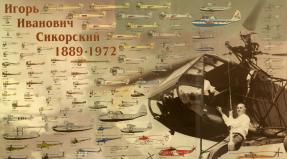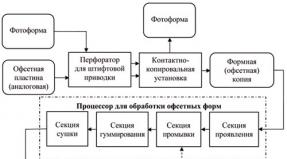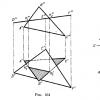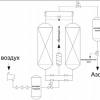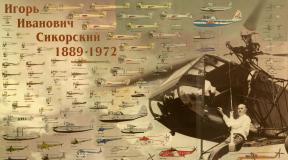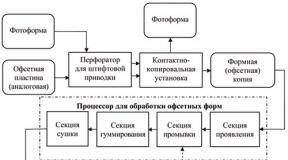Great Russian inventions that turned the world upside down. The most famous inventor The most outstanding inventions
In 1908-1911 he built his first two simple helicopters. The carrying capacity of the apparatus, built in September 1909, reached 9 pounds. None of the helicopters built could take off with a pilot, and Sikorsky switched to building airplanes.
Sikorsky's airplanes won top prizes at a military aircraft competition
In 1912-1914, he created the Grand (Russian Knight) and Ilya Muromets aircraft in St. Petersburg, which laid the foundation for multi-engine aviation. On March 27, 1912, on the S-6 biplane, Sikorsky managed to set world speed records: with two passengers on board - 111 km/h, with five - 106 km/h. In March 1919, Sikorsky emigrated to the United States and settled in the New York area.

The first experimental helicopter, the Vought-Sikorsky 300, created by Sikorsky in the USA, took off from the ground on September 14, 1939. Essentially, it was a modernized version of his first Russian helicopter, created back in July 1909.
His helicopters were the first to fly across the Atlantic and Pacific oceans (with in-flight refueling). Sikorsky machines were used for both military and civilian purposes.
He is the creator of the first accurately dated printed book "Apostle" in the Russian Kingdom, as well as the founder of a printing house in the Russian Voivodeship of the Kingdom of Poland.
Ivan Fedorov is traditionally called “the first Russian book printer”
In 1563, by order of John IV, a house was built in Moscow - the Printing House, which the tsar generously provided from his treasury. The Apostle (book, 1564) was printed in it.
The first printed book in which the name of Ivan Fedorov is indicated ( and Peter Mstislavets who helped him), it was “Apostle”, work on which was carried out, as indicated in the afterword to it, from April 19, 1563 to March 1, 1564. This is the first accurately dated printed Russian book. The following year, Fedorov’s printing house published his second book, “The Book of Hours.”
After some time, attacks began on printers from professional scribes, whose traditions and income were threatened by the printing house. After the arson that destroyed their workshop, Fedorov and Mstislavets left for the Grand Duchy of Lithuania.
Ivan Fedorov himself writes that in Moscow he had to endure very strong and frequent bitterness towards himself, not from the tsar, but from state leaders, clergy and teachers who envied him, hated him, accused Ivan of many heresies and wanted to destroy God’s work (i.e. printing). These people drove Ivan Fedorov out of his native Fatherland, and Ivan had to move to another country, which he had never been to. In this country, Ivan, as he himself writes, was kindly received by the pious King Sigismund II Augustus along with his army.
Russian physicist and electrical engineer, professor, inventor, state councilor, Honorary electrical engineer. Inventor of radio.
The activities of A. S. Popov, which preceded the discovery of radio, included research in the field of electrical engineering, magnetism and electromagnetic waves.
On May 7, 1895, at a meeting of the Russian Physical-Chemical Society, Popov made a report and demonstrated the world’s first radio receiver that he had created. Popov ended his message with the following words: “ In conclusion, I can express the hope that my device, with further improvement, can be applied to the transmission of signals over a distance using fast electrical oscillations, as soon as a source of such oscillations with sufficient energy is found».
On March 24, 1896, Popov transmitted the world's first radiogram over a distance of 250 m, and in 1899 he designed a receiver for receiving signals by ear using a telephone handset. This made it possible to simplify the reception circuit and increase the radio communication range.
The first radiogram transmitted by A. S. Popov to the island of Gogland on February 6, 1900, contained an order for the icebreaker Ermak to go to the aid of fishermen carried out to sea on an ice floe. The icebreaker complied with the order, and 27 fishermen were rescued. Popov established the world's first radio communication line at sea, created the first military and civilian radio stations, and successfully carried out work that proved the possibility of using radio in the ground forces and in aeronautics.
Two days before his death, A.S. Popov was elected chairman of the physics department of the Russian Physico-Chemical Society. With this election, Russian scientists emphasized the enormous merits of A. S. Popov to Russian science.
Cherepanov brothers
In 1833-1834, they created the first steam locomotive in Russia, and then in 1835 - a second, more powerful one.
In 1834, at the Vyisky plant, which was part of Demidov’s Nizhny Tagil factories, Russian mechanic Miron Efimovich Cherepanov, with the help of his father Efim Alekseevich, built the first steam locomotive in Russia entirely from domestic materials. This word did not yet exist in everyday life, and the locomotive was called a “land steamer.” Today, a model of the first Russian steam locomotive, type 1−1−0, built by the Cherepanovs, is kept in the Central Museum of Railway Transport in St. Petersburg.
The first locomotive had a working weight of 2.4 tons. Its experimental trips began in August 1834. The production of the second locomotive was completed in March 1835. The second locomotive could transport cargo already weighing 1000 pounds (16.4 tons) at a speed of up to 16 km /h.
Cherepanov was denied a patent for a steam locomotive because it was “very smelly”
Unfortunately, unlike stationary steam engines, which were in demand by Russian industry at that time, the first Russian railway of the Cherepanovs was not given the attention it deserved. The now found drawings and documents characterizing the activities of the Cherepanovs indicate that they were true innovators and highly gifted masters of technology. They created not only the Nizhny Tagil railway and its rolling stock, but also designed many steam engines, metalworking machines, and built a steam turbine.
Russian electrical engineer, one of the inventors of the incandescent lamp.
As for the incandescent lamp, it does not have one single inventor. The history of the light bulb is a whole chain of discoveries made by different people at different times. However, Lodygin's merits in the creation of incandescent lamps are especially great. Lodygin was the first to propose using tungsten filaments in lamps ( In modern light bulbs, the filaments are made of tungsten) and twist the filament in the shape of a spiral. Lodygin was also the first to pump air out of lamps, which increased their service life many times over. And yet, it was they who put forward the idea of filling light bulbs with inert gas.
Lodygin is the creator of the autonomous diving suit project
In 1871, Lodygin created a project for an autonomous diving suit using a gas mixture consisting of oxygen and hydrogen. Oxygen was to be produced from water by electrolysis, and on October 19, 1909, he received a patent for an induction furnace.
Andrey Konstantinovich Nartov (1693—1756)
Inventor of the world's first screw-cutting lathe with a mechanized slide and a set of replaceable gears.
Nartov developed the design of the world's first screw-cutting lathe with a mechanized slide and a set of replaceable gears (1738). Subsequently, this invention was forgotten and the screw-cutting lathe with a mechanical slide and a set of replaceable gears was reinvented around 1800 by Henry Models.
In 1754, A. Nartov was promoted to the rank of general, state councilor
While working in the Artillery Department, Nartov created new machines, original fuses, proposed new methods for casting guns and sealing shells in the gun channel, etc. He invented an original optical sight. The significance of Nartov’s inventions was so great that on May 2, 1746, a decree was issued to reward A.K. Nartov with five thousand rubles for artillery inventions. In addition, several villages in the Novgorod district were assigned to him.
Boris Lvovich Rosing (1869—1933)
Russian physicist, scientist, teacher, inventor of television, author of the first experiments on television, for which the Russian Technical Society awarded him a gold medal and the K. G. Siemens Prize
He grew up lively and inquisitive, studied successfully, and was fond of literature and music. But his life turned out to be connected not with humanitarian areas of activity, but with the exact sciences. After graduating from the Faculty of Physics and Mathematics of St. Petersburg University, B. L. Rosing became interested in the idea of transmitting images over a distance.
By 1912, B. L. Rosing developed all the basic elements of modern black and white television tubes. His work became known in many countries at that time, and his patent for the invention was recognized in Germany, Great Britain and the USA.
Russian inventor B. L. Rosing is the inventor of television
In 1931, he was arrested in the “case of academicians” “for financial assistance to counter-revolutionaries” (he lent money to a friend who was subsequently arrested) and exiled to Kotlas for three years without the right to work. However, thanks to the intercession of the Soviet and foreign scientific community, in 1932 he was transferred to Arkhangelsk, where he entered the department of physics of the Arkhangelsk Forestry Engineering Institute. There he died on April 20, 1933 at the age of 63 from a cerebral hemorrhage. On November 15, 1957, B. L. Rosing was completely acquitted.
05/18/2016 at 22:33 · Pavlofox · 16 710
The most famous inventors
Some of the greatest people of all time are the founders of the modern civilization in which humanity now lives. Thanks to brilliant minds, modern man has at his disposal devices and technologies that bring maximum comfort to his life.
Let's meet these famous people. Who are the most famous inventors?
10.
Opens a list of the greatest scientists and inventors. His invention is considered to be an aerodynamic machine, with the help of which meteorological instruments were lifted into the air. Lomonosov is also credited with creating the prototype of a modern aircraft. In addition, he is one of the greatest physicists and chemists of his time. The scientist's interests and activities were varied and extensive. He was interested in astronomy, geography, geology, history, philology and other sciences.
9.

Humanity owes the creation of radio and radio technology to such a great mind as. The Russian inventor took part in the creation of the first radio workshop. For his services to the Fatherland in the development of science, he was awarded many awards. In 1898, he received a prestigious award from the Imperial Russian Technical Society “for a receiver for electrical oscillations and instruments for telegraphing at a distance without wires.” In addition, Popov was engaged in teaching activities. Among the subjects he taught were physics, electrical engineering and mathematics.
8.

Self-taught Russian scientist Konstantin Eduardovich Tsiolkovsky refers to the most famous inventors of the USSR. It is he who is considered the founder of theoretical cosmonautics and aerodynamics. Tsiolkovsky is the inventor of the wind tunnel. At the end of the 19th century, he managed to create the design of an airplane with a metal frame, but it was possible to build the device only two decades later. In addition, Tsiolkovsky was a creative person who created a number of works of art.
7.

He is included in the list of the world's most famous inventors, writers and political figures. Among all the discoveries of this brilliant man, one can highlight the creation of a lightning rod, Franklin furnace, glass harmonica, etc. His contribution to medicine is the invention of a flexible urinary catheter. None of Franklin's discoveries were ever patented by him. The scientist was of the opinion that any of the inventions should be open free of charge.
6.

He is one of the greatest minds of all mankind. His contribution to science can hardly be overestimated. First of all, Archimedes is known as a brilliant mathematician. Among his practical inventions are siege weapons, as well as mirrors capable of setting fire to material by focusing the sun's rays. The latter invention was used to set fire to sails on Roman ships. In addition, the mathematician made his contribution to the development of mechanics. He was one of the first to demonstrate the complete theory of leverage in practice. His invention, which is called the Archimedes screw, is still relevant today. Using this device, water can be transferred from low-lying reservoirs to irrigation canals.
5.

He is one of the most famous scientific minds in the USA. The inventor was able to obtain more than six hundred patents throughout his life. The scientist contributed to the development of industrial robots, automated warehouses and wireless radiotelephones. He created a fax machine, a video recorder and even a video camera. The magnetic tape cassette is also his invention. Lemelson was considered one of the most famous figures of his time. He was an active champion of the rights of independent scientists, which is why he was disliked by patent offices and many commercial companies. Lemelson was a true workaholic who worked 14 hours a day. Almost every night, the scientist got up several times to write down his next brilliant idea in a notebook, and in the morning he could demonstrate new projects for his future inventions.
4.

Unrecognized during his lifetime as a great scientist, today he is one of the ten most famous inventors. He made a huge contribution to the creation of equipment that runs on alternating current. In addition, thanks to Tesla, multiphase systems, synchronous generators, etc. appeared. His discoveries marked the beginning of the second industrial revolution. The inventor's contributions to science are related to the fundamentals of robotics, remote control and computer science. Nikola Tesla is the owner of more than a hundred patents. Only his descendants could appreciate his achievements in the world of inventions.
3.

He is one of the most popular scientists who has made a huge contribution to the development of humanity. One of the great minds was able to create the telephone as a result of his work with deaf patients. The audiometer is also Bell's brainchild. In addition, he owns such human creations as a metal detector and one of the first airplanes. Subsequently, the inventor created an institute named after. Volta, where improvements were made to telephony, electrical communications and the phonograph. The institute was opened with the proceeds from the creation of a telephone company. He also created the National Geographic Foundation.
2.

He is one of the greatest minds of all time and one of the most famous inventors. Edison is the holder of more than 1,000 patents in the United States alone and about 3,000 worldwide! It is he who is credited with such achievements in the world of inventions as the improvement of the telegraph, telephone and film equipment. He is considered one of the first to invent a successful version of the incandescent lamp. He owns such an invention as the phonograph. In the 28th year of the last century, the great scientist was awarded one of the most prestigious awards - the Congressional Gold Medal. Edison worked 17 hours a day. It was hard work and perseverance that helped him achieve such success.
1.

Tops the list of the most famous and greatest inventors of all time. Fame came to the scientist with the invention of the first car. He was the first to design a mobile vehicle with an internal combustion engine. After this, the first automobile company appeared, which began to actively implement Karl Benz's innovations and created the first car called Mersedes Benz. The scientist received a patent for a two-stroke gasoline engine in 1878. Later he patented all the important components and systems of the future mobile transport. We cannot appreciate the contribution to the development of science and progress made by Benz. Thanks to this man, billions of people move freely around the world on a four-wheeled structure. By the way, the first car had only three wheels.
Readers' Choice:





About invention in clear language and with interesting examples Sokolov Dmitry Yurievich
Chapter 5 Great inventors and their inventions
Mens ogitat molen.
Mind moves matter.
(From Virgil)
In the previous chapter, the basic principles of invention were formulated, based on the statements of great inventors. In this chapter, taking into account their inventive experience, we will try to complement these principles together with them.
Many consider Archimedes (287–212 BC), born in Syracuse on the island of Sicily, to be the first of the great inventors of all times and peoples. According to P.S. Kudryavtsev, Archimedes was also a very important representative of “mathematical physics or, rather, physical mathematics.” This combination of science and its implementation in technology allowed him to take a well-deserved place in the history of mankind. Everyone knows Archimedes' law about the buoyant force of a liquid, which is equal to the weight of its displaced volume, and its application as a way to identify precious metals (Fig. 5.1). His other famous inventions relate to the military field and mainly use the "lever principle", although the lever was already used in Ancient Egypt. The Greek historian Plutarch wrote: “When the Romans attacked... Archimedes set into motion his machines. The land army was struck by a hail of projectiles and huge stones thrown with great speed. Nothing could withstand their blow, they overthrew everything in front of them and brought confusion to the ranks. As for the fleet, suddenly, from the height of the walls, logs, due to their weight and imparted speed, fell onto the ships and sank them. Then the iron claws and beaks grabbed the ships, lifted them into the air with their nose up, their stern down, and plunged them into the water. And then the ships were set into rotation and, circling, fell on underwater rocks and cliffs at the foot of the walls... A terrible sight!...".
Rice. 5.1. Archimedes (Eureka). Illustration for the Basel edition of “Ten Books on Architecture” by Vitruvius. 1575
However, the weapon he invented did not save Archimedes from death during the capture of Syracuse by Rome; he went down in history as one of the first scientists who worked for the war, and who turned out to be its victim. When Syracuse was taken, the conquerors wanted to save Archimedes' life. The soldiers who entered Archimedes' house asked who he was (Archimedes was working on drawings at that time). Instead of answering a simple question, he covered the drawings with his hands with the words “Noli turbare circulos meos” (don’t touch my circles), after which he was killed.
The life and work of Archimedes shows that, Being both a scientist and an inventor allows you to achieve maximum success in both areas. And the last tragic example shows how important his scientific achievements are for a scientist. Having singled out Archimedes especially as the first of the greats, we will continue to adopt experience.
Galileo Galilei (1564–1642) made his first discovery of the constancy of the frequency of oscillations of a pendulum with the same length of suspension at the age of twenty, when he observed the swinging of chandeliers in the Cathedral of Pisa. . At the same time, he kept track of time by the beat of his pulse and the rhythm of the music. Returning home, he used two lead balls of different masses, suspended on threads of the same length, as well as pendulums made of other materials, excluding the lightest one, which was affected by air resistance. All these experiments confirmed his initial guesses. Strictly speaking, this is not an invention, but a discovery, but close observation of the world around us is very important for both the scientist and the inventor.
Christian Huygens (1629–1695) is considered Galileo's successor in science. Using the laws of the pendulum discovered by Galileo, he made a full-fledged invention in the form of a pendulum clock. Huygens spent almost 40 years perfecting this watch, for which he was called the most brilliant watchmaker of all time. Consequently, in order to earn the gratitude of descendants, sometimes you need to spend a lot of time solving one issue. Let us immediately note that of all the great predecessors, Huygens especially singled out Archimedes.
Mikhail Vasilyevich Lomonosov (1711–1765), along with discoveries that were ahead of their time (for example, the molecular kinetic theory of heat and physical chemistry as a science), created a huge number of inventions in various fields. He attached paramount importance to combining science with practice to solve specific problems. In the first chemical laboratory of Russia, the prototype of future research institutes, in 1749–1751 he created new and found lost recipes for coloring glass and a special mosaic mass - smalt. One of Lomonosov’s most outstanding inventions was the “night vision scope” - the prototype of the night binoculars created two hundred years later. He also invented: a periscope, a refractometer, a pyrometer, various versions of barometers and much more. In addition, Lomonosov invented the words: pendulum and constellation. The example of Lomonosov confirms the experience of Archimedes, showing the high efficiency and mutual influence of scientific and inventive activities.
The first invention of one of the most prominent scientists of the 19th century, James Clerk Maxwell (1831–1879), was made at the age of 14 after he attended a lecture at the Royal Scientific Society of Edinburgh, where his father sometimes took him. It was about constructing ovals, for which at that time a complex mathematical apparatus developed by Newton and Descartes was used. The method invented by Maxwell is that a loose thread is wrapped around two needles stuck into the surface, and a pencil is moved along its inner contour with tension. Maxwell was lucky; Professor D. Forbes reported this invention on his behalf to the Edinburgh Society, and it was appreciated by scientists. It should be noted that Maxwell already understood then that it is very important for an inventor and scientist to convey his thoughts to people in a timely manner. Together with it we can formulate the principle: "Work, finish, publish" which has now become fundamental for all scientists and inventors.
An interesting example is that of Alfred Nobel (1833–1896), whose motivation for inventing dynamite in 1867 was, among other things, to achieve peace on earth. He believed that powerful explosives, producing enormous destruction, would frighten humanity and eliminate wars. He even set a well-known premium on profits from the sale of ammunition, including for strengthening peace. But the First and Second World Wars proved his assumptions wrong.
As if taking into account Nobel's experience, the scientific world did not notice the publications of biologist and physicist Leo Szilard in 1933 and chemist Ida Noddack regarding the use of nuclear energy. This may have delayed the invention of nuclear weapons and saved humanity from mass destruction during World War II.
Inventive activity played a cruel joke on Lev Sergeevich Termen (1896–1993). His invention, the Theremin vox, which generates sounds of different frequencies depending on the position of the operator’s palms relative to the antenna, was demonstrated in 1922 by V.I. Lenin and was positively assessed by him. Thanks to this, in 1928, Termen, as a Soviet citizen, moved to America to produce these devices, where, on instructions from Soviet intelligence, he organized the Teletouch company, under whose cover many of our intelligence officers worked. However, in 1938, Theremin was recalled to Moscow, where he was charged that he, from America, using his inventions, should send a radio signal to explode a bomb in the Foucault pendulum of the Pulkovo Observatory at the moment S.M. approaches it. Kirov. The inventor went through Stalin’s camps, “sharashkas,” oblivion and success, and at the end of his life in 1991, at the age of 95, he joined the ranks of the CPSU, explaining his action by saying that he promised it to Lenin. The above example confirms that mental activity helps to survive in extreme conditions and maintain love of life and optimism. To prove this, Termen suggested reading his last name backwards: “Theremin does not die.”
I would like to finish about the great inventors, who in most cases were outstanding scientists, with the opposite example of Wolfgang Pauli (1900–1958), an outstanding scientist, whom, according to L.D.’s humorous classification of the brightness of his talent. Landau was placed in first class right after Einstein, Bohr, Fermi and Heisenberg. So, the second humorous classification of experimental physicists says that the more significant a theoretical physicist is, the less he understands practical issues and even devices invented by someone can cause irreparable harm. When an explosion occurred in the physical laboratory of Göttingen, James Frank, the head of this laboratory, determined that at that very time a train was stopping at a station several kilometers from Göttingen, in which Pauli happened to be passing through. Based on this, Frank established that Pauli is the greatest theorist of all time. The conclusion is comic, however, there is an exception to every rule, and not all outstanding scientists become inventors.
Almost all of the examples given, in addition to the useful experience of great inventors, which has not lost its relevance at the present time, also emphasize the connection of times in science and technology. But more about this in the next chapter.
Literature
1. Kudryavtsev P.S. Course on the history of physics. – M.: Education, 1982, p. 30–31.
2. Vavilov V.V. First steps in science. – Potential, 2010, No. 8, p. 12–21.
3. Ishlinsky A.Yu., Pavlova G.A. M.V. Lomonosov is a great Russian scientist. – M.: Pedagogy, 1986, p. 57–60.
4. Belyavsky M.T. Experienced everything and penetrated everything. – M.: Moscow University Publishing House, 1990. – 221 p.
5. Pestov S. The Second Coming: Nanotechnology. - M. Zelenograd.: 1997, publishing house "Steel". – 100s.
6. Gladun A.B. The same age as the quantum. – Potential, 2010, No. 7, p. 2–4.
7. Gladun A.B. The same age as the quantum. – Potential, 2010, No. 4, p. 2–3.
From the book Treatise on Inspiration That Gives Birth to Great Inventions author Orlov Vladimir IvanovichCHAPTER ONE, where a leisurely discussion of the characteristics that distinguish every invention begins; the conversation is about novelty, but is interrupted by bitter thoughts about why acquirers get rich, and inventors become poor and go bankrupt; the reader faces mournful
From the book What awaits us when oil runs out, the climate changes, and other disasters break out author Kunstler James HowardCHAPTER TWO, where the previous discussion is continued in order to confirm the conclusion that another essential feature of any invention is its usefulness, expediency; categories such as whim, harm and benefit are considered, and shown as high
From the book Four Lives of Academician Berg author Radunskaya Irina Lvovna From the book About Invention in clear language and interesting examples author Sokolov Dmitry YurievichCHAPTER TEN, which proves that inspiration can flow from the past, that inventors sometimes repeat technical ideas of past years at a new, dizzyingly high level 10.1.Denmark in the era of the Napoleonic wars verbally declared its neutrality, and
From the book Bolt systems "fractures" author Maslov Yuri AnatolievichCHAPTER TWELVE, where author and reader together leaf through books in which hints and direct promises are given to reveal secrets of how to make inventions with the same ease as solving mathematical problems; while reading, the illusion arises that a technique already exists
From the book Invention Algorithm author Altshuller Genrikh Saulovich From the book Russia - the Birthplace of Radio. Historical essays author Bartenev Vladimir GrigorievichChapter 3 COMPLEX FAIRWAYS OF DEAD POINT How will this unusual and ordinary story develop further? A story so similar to those that play out around us and with us in everyday and always so unique life. Events in Berg’s personal life were brewing. In the People’s Commissariat
From the author's bookChapter 2 The most ancient inventions Vestra salus – nostra salus. Your good is our good. According to the latest data from traditional archeology, the first invention of ancient man was a stone knife (chopper), which the inhabitants of Northeast Africa used to scrape meat from animal bones. These
From the author's bookChapter 3 How inventions are born Quot hominess tot sententiae. How many people - so many opinions. The well-known developer of methods for solving inventive problems, Genrikh Saulovich Altshuller, noted that “inventors are not very willing and do not often talk about the paths that led them to
From the author's bookChapter 7 Inventors and power Inpatria natus non est prophet a vocatus. There is no prophet in his own country. (Gospel of John, 4,44) Recently, on duty, finding myself in a well-known technical university in Moscow, I decided to go to the library and leaf through the files of the main journals for
From the author's bookChapter 8 What inventors often think about each other Abe ant studia in mores. Activities leave an imprint on character. If you answer in one word, then they not only think badly, but also speak and even do. Put yourself in the inventor's shoes. You spend more than one day solving a problem,
From the author's bookChapter 10 Other interesting inventions and the composition of their formulas Faciant meliora potentes. Let those who can do it better. In this chapter, we will look at the compilation of formulas for inventions, which, due to their originality, left a mark in the history of invention. Scientists have long
From the author's book From the author's bookDialectics of Invention Even formal logic represents, first of all, a method for finding new results, for moving from the known to the unknown; the same thing, only in a much higher sense, is dialectics. F.
From the author's book7. Oleg Vladimirovich Losev and his inventions, ahead of their time In this chapter we will talk not only about the scientific research of O.V. Losev, but we will also show the significance of his inventions from a modern perspective. What is characteristic of the scientific heritage of O.V. Loseva? First of all, this is what
In this article we will talk about the greatest inventors of the world at all times. These people are perhaps the most famous inventors in history.
List of inventors:
Archimedes of Syracuse
(287 - 212 BC)
Archimedes was from Syracuse, so he received the nickname Archimedes of Syracuse. He is primarily known as an outstanding mathematician, physicist and engineer. His interests also included astronomy and, of course, inventions. The life of Archimedes is known only in general details, so a complete biography cannot be found
Overall, he is considered one of the great mathematicians of antiquity and one of the greatest of all time. Archimedes anticipated modern calculus and analysis by using the concepts of infinitesimals and the method of exhaustion to derive and rigorously prove a number of geometric theorems, including accurately calculating the area of a circle, the surface area and volume of a sphere, and the area under a parabola.

Archimedes screw for raising water in irrigation systems.
Other mathematical achievements include obtaining an accurate approximation of Pi, identifying and studying the spiral that was named after him (the Archimedean spiral), and creating a system for expressing very large numbers using exponentiation. He was also one of the first to apply mathematics to physical phenomena, laying the foundations of hydrostatics and statics, including the physical explanation of the operation of levers, which is now all taught in school physics lessons. It is known that Archimedes actively tried to improve and automate various tasks. One of the most famous problems he solved was the problem of raising water in irrigation systems, which he solved with the help of an innovative invention - a special auger screw. He also invented compound pulleys and defensive machines to protect his native Syracuse from invasion.
(10 - 75 AD)

Heron of Alexandria was a mathematician and engineer who worked in his hometown of Alexandria, Roman Egypt. He is considered the greatest experimentalist of antiquity, and his work is a development of the Hellenistic scientific tradition.
He was busy developing geometry, mechanics, hydrostatics, and optics. He has written a number of scientific papers (with an emphasis on practice) in all these areas. During the Dark Ages, his name was forgotten, and his inventions ceased to be of any interest to the people of that time.

Among his inventions you will find the first robotic systems, self-loading crossbows, music boxes, vending machines and much more that seems incredible for that time. Heron also published a well-known description of a steam device called an aeolipile (sometimes called "Heron's engine" or "Heron's steam turbine"). They say that he was a follower of the atomists.
Leonardo da Vinci

Leonardo da Vinci was an Italian Renaissance polymath, that is, a man whose intellect allowed him to expand beyond one area of interest. His interests included invention, painting, sculpture, architecture, science, music, mathematics, technology, literature, anatomy, geology, astronomy, botany, writing, history and cartography. Among scientists, he is rightfully considered the progenitor of paleontology, paleoichnology and architecture. In the artistic community you can often find him rated as the greatest artist of all time. He personifies the ideal of Renaissance humanism.

In history and science, Leonardo is considered the main example of the "universal genius" or "Renaissance man", a man of "unquenchable curiosity" and "feverishly inventive imagination". According to art historian Helen Gardner, the scope and depth of his interests were unprecedented in history, and "his mind and personality seem to us superhuman, while he himself was a man of mystery and distance." Marco Roski notes that although there are many myths, hypotheses and assumptions around Leonardo’s life, Vinci’s very thinking and perception of the world was quite logical using empirical methods of cognition, which for those times were a violation of generally accepted rules and dogmas.

Leonardo is deeply respected for his fantastic ingenuity. He created concepts for flying machines (planes, helicopters, parachutes) and so on, military vehicles (tank, rapid-fire crossbows, assault ladders, etc.), construction vehicles (excavator, various cranes and ladders, etc.), musical machines, culinary machines and much more. more. During his lifetime, not many of his inventions were built, which can be explained by the low level of development of industry, metallurgy and technology at that time. However, some of his smaller inventions, such as the automatic bobbin winder and the machine for testing the tensile strength of wire, entered the industrial world unfinished. Although his achievements now seem simply enormous to us, he, unfortunately, did not have a direct impact on the development of science, since he did not publish many of his findings without sharing them with the scientists and inventors of that time.
Kulibin Ivan Petrovich

Ivan Petrovich Kulibin was a Russian mechanic and inventor. He was born in Nizhny Novgorod and even later received the nickname “Nizhny Novgorod Archimedes.” Since childhood, he showed interest in creating mechanical products. Soon his interest grew into creating watch movements. His products and fertile imagination inspired many inventors.
 His most famous invention is the design of a bridge across the Neva River, thereby simulating such a complex bridge for the first time. In addition, he invented various automated mechanisms, for example, a scooter with a pedal mechanism and even mechanical prostheses. His area of interest also concerned water transport, where he also made a number of inventions.
His most famous invention is the design of a bridge across the Neva River, thereby simulating such a complex bridge for the first time. In addition, he invented various automated mechanisms, for example, a scooter with a pedal mechanism and even mechanical prostheses. His area of interest also concerned water transport, where he also made a number of inventions.

He was primarily known among the masses as the inventor of funny toys and fireworks with which he entertained people. All this greatly surprised his contemporaries. Interestingly, he was an absolute teetotaler, did not gamble and did not smoke tobacco.
James Watt

James Watt was born in Scotland. He was an inventor, mechanical engineer and chemist. He is primarily known for improving Thomas Newcomen's steam engine. It was Watt's steam engine that became the foundation for the industrial revolution both in Great Britain and throughout the world. After its modernization, the efficiency of the steam engine increased by 4 times or more, and its control became easier.
A detailed explanation of all the principles of operation of the Watt steam engine and the physics of the process can be seen in the video below:
In addition to mechanics and physics, Watt was interested in chemistry and invented a bleaching agent. In his old age, he even managed to engage in invention in art, trying to develop an eidograph (copying machine) for sculptures, developing the ideas of a pantograph (machine for copying maps). Watt also created the concept of measuring horsepower, and later scientists decided to name the SI unit of power (watt), which we now see on every light bulb, after Watt.
Nikola Tesla

Nikola Tesla is an outstanding Serbian-American inventor, without whom it is difficult to imagine the era of electricity in the 20th century. He was not only an engineer, physicist, designer and mechanic, but also a great futurist dreamer.
He received his education in the Austrian Empire, and in 1884 he emigrated to the United States, where he received citizenship. After which he developed an AC induction motor, and also patented a number of other AC-related inventions, which eventually became the heart of the Westinghouse polyphase system.

3-phase electric motor rotating in a magnetic field
Having earned a significant amount of money, he continues his experiments in the field of electricity. He experiments with discharge tubes and tries to take the first pictures using X-rays. He was the first to build a small boat with wireless control, which he demonstrated at an exhibition, which surprised his contemporaries, since they could not understand how it was controlled.

Later, he came up with the idea of wireless lighting and worldwide wireless power distribution. In his laboratory in Colorado Springs, he conducts experiments with high-voltage and high-frequency electricity. The point was that he wanted to wirelessly transmit electricity between entire continents! But he didn't have enough money and couldn't finish it. Later, a unit for measuring induction in a magnetic field would be named in honor of Tesla.
